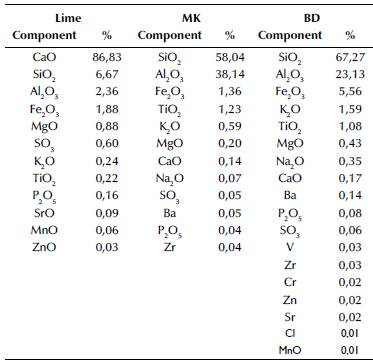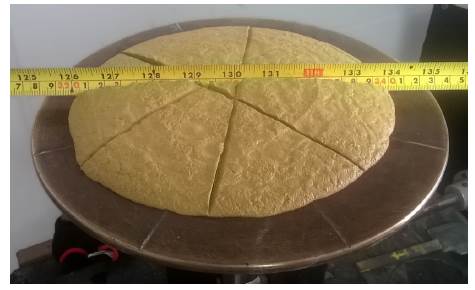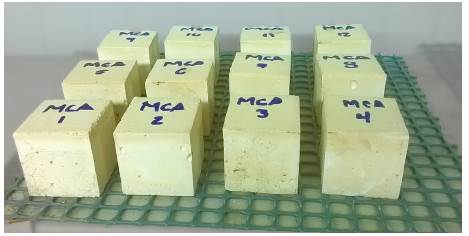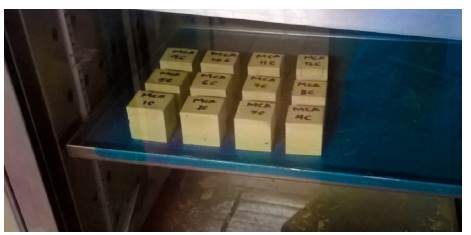Introduction
Lime mortars are materials that have been frequently used throughout history, and their use has expanded since ancient times (Luo et al., 2020; Luque et al., 2010; Zhang, et al., 2020; Zhang et al., 2018). Thus, most masonry buildings built before the 20th century contain mostly lime mortars (Delgado Rodrigues, 2020; Pozo-Antonio, 2015). However, with the introduction of Portland cement in 1824 and its benefits, such as rapid hardening and high mechanical strength, the usage of lime binders decreased Radonjic et al., 2001, as cited in Luque et al., 2010; Zhang et al., 2018).
A great number of masonry buildings that have lime mortar as a bond of their masonry units have begun to show deterioration after a good part of their service life. This is due to the incidence of different factors, such as the changes in the use of the structure (Mercado, 2007; Peñaranda, 2011), partial demolition of the property (Peñaranda, 2011), foundation settlement (Maldonado et al., 2011), the use of materials that are incompatible with the original ones (Lourenço et al., 2014), or simply because of the effects of the passage of time (Maravelaki-Kalaitzaki et al., 2005; Torney et al., 2015).
This is how, during most of the 20th century, cement mortars were employed in the restoration of heritage buildings (Vejmelková et al., 2012). Over time, different authors indicated that using cement mortars in heritage restorations resulted in some inconveniences for the structures, such as the crystallization of salts and the low flexibility of cement-based mortars (Pozo-Antonio, 2015; Vavričuk et al., 2018; Zhang et al., 2020). Therefore, in some historical buildings, it has been observed that the deterioration process accelerates after restoration interventions (Gleize et al., 2009; Vejmelková et al., 2012), due to the incompatibility between cement mortars and the original materials (Aalil et al., 2019; Lanas and Alvarez, 2003).
Certainly, at the moment of rehabilitating a heritage building, the starting point for an adequate selection of the repair materials is analyzing the ones thet already exist in the structure (Forster, 2010; Gleize et al., 2009; Maravelaki-Kalaitzaki et al., 2005; Morillas et al., 2019; Torney et al., 2015). Hence, it is important to consider that historic structures have constructive characteristics and materials that differ from modern ones (Lourenço et al., 2013).
Moreover, the materials vary in their composition, which is why there are uncertainties related to the environmental conditions to which they are exposed (Ball et al., 2011; Koutník et al., 2020). Thus, restoration mortars must be selected from the study of the ancient materials and their decay, as well as from the environmental factors affecting the structure (Apostolopoulou et al., 2018).
Lime mortars, in turn, have certain advantages, such as physical-chemical compatibility with older binders; higher plasticity, which allows them to accommodate to the deformations implied by masonry; and good water vapor permeability (de Nardi et al., 2017; Lanas and Alvarez, 2003; Pozo-Antonio, 2015; Vavričuk et al., 2018; Zhang et al., 2018). On the other hand, there are some inconveniences when using lime binders, such as low strength, slow hardening, poor water resistance, high retraction, and low cohesion between the mortars and the masonry units (Vavričuk et al., 2018; Zhang et al., 2018). To mitigate these problems, admixtures rich in aluminum-silicates (Zhang et al., 2020) such as metakaolin or brick dust are employed (Nezerka et al., 2016).
Furthermore, the hardening process of lime mortars stems from the reaction between the CO2 present in the atmosphere and the Ca(OH)2 of the lime (Pavlík et al., 2012; Zhang et al., 2020), which transforms into CaCO3 (Arizzi et al., 2011; Ergenç et al., 2018; Luque et al., 2010). Thus, the carbonation ratio of these mortars is a decisive factor that influences the strength and durability of these mixtures (Arizzi et al., 2011; El-Turki et al., 2009; Pavlík et al., 2012). This is due to the fact that the reaction with the environment generates changes in the structure of the mortars (Arandigoyen and Alvarez, 2006; Cazalla, 2002; Ergencj et al., 2018). Moreover, it seems that, during the process, there is an increase in the mass and volume of the hardened particles (Pavlík et al., 2012). Likewise, it has been observed that said phenomenon starts from the outer zone to the inner zone of the binders (Arizzi et al., 2011; Delgado Rodrigues, 2020).
Therefore, different works of research have been conducted at an international level to evaluate lime mortars. These studies have found that the development of strength is related to the quality of the lime (Lanas and Alvarez, 2003) since it influences the mechanical and hydraulic properties of the mixtures (Vejmelková et al., 2012). It has been noted that the hardening ratios of these mortars are low, which is relected on the evolution of their mechanical properties (Moropoulou et al., 2005). This is due to the fact that the maximum strength that these binders achieve is linked to the presence of non-carbonated portlandite (Garijo et al., 2020; Lanas and Alvarez, 2003). Additionally, the stiffness of the mortars increases during the hydration of the materials' hydraulic components. Due to the chemical reactions that take place, the curing conditions inluence the mechanical strength (Pozo-Antonio, 2015). Likewise, as the lime/aggregate ratio decreases, so does the strength (Lanas and Alvarez, 2003), which is why mortars with higher lime contents show higher strength values. This is explained by the fact that, as they are more porous, the carbonation process occurs at a higher rate, and, therefore, the development of the mechanical properties improves (Lanas et al., 2006).
As mentioned before, using admixtures rich in aluminum-silicates can mitigate some problems encountered in lime mortars. Among these admixtures is metakaolin, a material that has several advantages when used in mortar mixtures, such as an increased mechanical strength, improved resistance to chemical attacks, increased durability, decreased retraction, and more (Cazalla, 2002; Siddique, 2008; Vavričuk et al., 2018). Accordingly, in lime mortars added with metakaolin, mechanical and micro-structural properties compatible with those found on traditional materials have been observed (Vejmelková et al., 2012). Thus, they are useful for masonry rehabilitations (Aggelakopoulou et al., 2011). On the other hand, some studies have evidenced a decrease in the long-term strength of this type of mortar, which is attributed to the emergence of micro-cracks due to the mixtures' retraction (Aggelakopoulou et al., 2011; Velosa et al., 2009). It seems that this decrease deepens as the metakaolin content increases (Vavričuk et al., 2018). Another relevant factor is the type of metakaolin, which can affect the properties of the mortar, as is the case of Velosa et al. (2009), who found that metakaolin rich in kaolinite and alumina can lead to mixtures with higher strength values.
Another material that has been used in lime mortar mixtures is brick dust, which can provide both economic and environmental benefits, considering that it has a high degradation resistance that hinders the conditioning of industrial waste (Matias et al., 2008). Additionally, crushed brick particles have been identified in some historic mortars. Even the roman architect Vitruvius, in his work The Ten Books on Architecture, recommended adding a portion of crushed bricks to the mortar mixtures, with the objective of increasing their durability and strength (Nezerka et al., 2016). Authors like Navrátilová Rovnaníková (2016), Matias et al. (2008), Nezerka et al. (2016), and Aalil et al. (2019) observed that adding brick dust to mortar mixtures improved their mechanical properties, which can be attributed to the reduction of retraction-related cracks, due to the presence of the brick grains (Nezerka et al., 2016). Therefore, this type of binder may be acceptable for repair mortars (Matias et al., 2008).
Considering the information provided above, the aim of this research was to evaluate the strength of mortars subjected to an accelerated carbonation process, in order to simulate the conditions of heritage building mortars. Furthermore, it was sought to evaluate the effect of admixtures such as metakaolin and brick dust, with the objective of obtaining the same properties of carbonated mixtures, therefore highlighting them as a rehabilitation alternative for lime mortar masonry in heritage buildings. This is important, as it opens the possibility of reinforcing existing structures by using materials with properties similar to those that are currently part of the structure.
Carbonation in lime mortars
The carbonation process of the mortars inluences their hardening ratio, durability, and mechanical strength (Pavlík et al., 2012) because the captured CO2 fixes into a matrix to form calcites, thus improving its properties (Luo et al., 2020). In general, five stages occur during this phenomenon (Arandigoyen and Alvarez, 2006; Papadakis et al., 1991, as cited in Cazalla, 2002; Kang et al., 2020; Pavlík et al., 2012): diffusion of the CO2 in the mixture, condensation of the water in the pores, dissolution of the Ca(OH)2, dissolution of the CO2 in the pore solution, and the precipitation of CaCO3. To summarize, carbonation is represented as the transformation of Ca(OH)2 into CaCO3 due to the presence of CO2. Equation (1) describes the entire process:
Reactions that occur between metakaolin and lime
Since metakaolin is a product based on silica and alumina, a reaction between the components of the pozzolan and the Ca(OH)2 of the lime is produced when mixing it with lime and water. In this way, calcium silicate hydrate (CSH) and crystalline products that include calcium aluminate hydrate (CAH), and aluminum silicate hydrates are produced (Gameiroa et al., 2014 as cited in Khatib et al., 2018; Siddique, 2008; Tebbal and Abidine Rahmouni, 2019).
Reactions that occur between brick dust and lime
The reactivity of the pozzolan can be affected by different factors: the quantity of silica and alumina, the firing temperature of the ceramic materials, the quantity and type of the clay that constitutes the ceramic pieces, the granulometry of the admixture, and the fineness of the crushed material. Therefore, when mixing the Ca(OH)2 of the lime with water and the silico-aluminous components of the ceramic pieces, a reaction occurs which produces calcium silicates and calcium aluminates. However, some studies indicate that the pozzolanic reaction depends on the reaction of silica and alumina with the CaO of the lime (Matias et al., 2014). This is analogous to the chemical phenomenon that occurs between metakaolin and lime when being hydrated with water. Moreover, the amorphous phase of the material has a large impact on its pozzolanicity.
Given the importance of preserving heritage buildings and using materials for their rehabilitation which are compatible with the existing ones, a project was developed to evaluate the evolution of the compressive strength of lime mortars subjected to two curing environments: a humidity and temperature chamber and an accelerated carbonation chamber. The mechanical behavior of lime mortar mixtures added with metakaolin (MK) and brick dust (BD) was assessed as well, with the objective of finding a short-term strength similar to that of the lime mortars in heritage buildings, which also increases due to the presence of CO2 in the atmosphere.
Materials and experimental methodology
For this study, lime (hydraulic) and pit sand (yellow or washed) with a bulk density of 2,68 g/cm3 and an absorption of 2,1% were acquired, which are representative of the typical Colombian heritage buildings. The metakaolin used as admixture was supplied by the Colombian company Insumos Industriales Corona, while the brick dust (maximum particle size of 300 μm) was obtained from nonstructural hollow clay bricks (33 cm x 11,5 cm x 23 cm, 'No. 5' in the Colombian market) that were residues from other tests. These were initially fragmented with a crusher (Figures 1 and 2), and then pulverized in a Los Angeles abrasion machine. The obtained dust was sieved through a 300 μm sieve. The chemical composition of the materials was determined with a MagixPro PW-2440 (WDXRF) X-ray luorescence spectrometer. Additionally, granulometric analyses of the sand and the brick dust were performed.
Physical and chemical properties of the materials
Table 1 shows the chemical composition of the lime, metakaolin (MK), and brick dust (BD) employed in this research.
Table 1 Chemical composition of the materials. XRF-148-16, XRF-024-17, and XRF-228-17 reports from the X-ray fluorescence laboratory of Universidad Nacional de Colombia, Bogotá.

Source: Authors
It can be observed that the lime has a high content of CaO, which is expected to transform into Ca(OH)2 when hydrated. This, in turn, will precipitate as CaCO3 during the carbonation process. Likewise, it can be appreciated that the material contains SiO2 and Al2O3, compounds that intervene in the formation of CSH and CAH when the lime is hydrated.
Regarding the metakaolin, it is mainly composed of SiO2 and Al2O3, making up 96,18% of its composition. Thus, when incorporating the admixture to lime and water, the components of the pozzolan intervene in the formation of CSH, CAH, and hydrated aluminum-silicates. The chemical composition of the metakaolin is similar to the one registered by authors such as Aggelakopoulou et al. (2011), Velosa et al. (2009), Vavričuk et al. (2018), and Vejmelková et al. (2012).
Regarding brick dust, it can be observed that it is largely composed of SiO2 and Al2O3, which make up 90,40% of its composition. This agrees with the results reported by Boke et al. (2006) and Aalil et al. (2019), who determined a high content of SiO2 in brick composition. Moreover, Matias et al. (2014) indicated that the pozzolanic reaction depends mainly on the presence of SiO2 and Al2O3, and that, when these compounds are mixed with water and lime, they may intervene in the formation of calcium silicates and calcium aluminates.
Figure 3 shows the granulometric curve of the sand. It can be observed that it has a high content of material passing through the No. 100 sieve (34%) and 20% of material passing through the No. 200 sieve.
Figure 4 presents the granulometric curve of the brick dust, which has approximately 42% of material passing through the No. 100 sieve and 12% passing through the No. 200 sieve.
Table 2 shows the weight proportions used in the elaboration of the mortars. These are typical dosages used in heritage buildings.
Table 3 presents the amount of materials per cubic meter of each mortar mixture. Additionally, to determine the amount of water required, a fluidity close to 100% was sought. To that effect, fluidity tests were performed following the guidelines of the NTC 5784 (ICONTEC, 2017) standard, since no other regulation exists at a national level which applies to the type of mortars employed in this study.
Figure 5 shows the fluidity test that guaranteed a proper workability of the mortars under study.
The compressive strength test specimens were mortar cubes with a 50 mm length, as shown in Figure 6. For their elaboration, the procedure described in the NTC 220 (ICONTEC, 2021) was used as reference. To that end, the materials were mixed, and the mixtures were placed on cubical molds. These were left for three days in a humidity and temperature chamber under the following controlled conditions: a temperature of 25±2 °C and a relative humidity of 55±5%. Afterwards, the samples were taken out of the molds and then cured. In total, 72 cubes were elaborated.
As mentioned before, two curing environments were evaluated: the first one consisted of a chamber with the humidity set at 55±5% and a temperature of 25±2 °C (Figure 7); the second one was an accelerated carbonation chamber (Figure 8) with the following controlled parameters: a temperature of 23 °C, a relative humidity of 65%, and a CO2 concentration of 5%. This process was conducted to accelerate the aging process of the mixtures, with the objective of simulating the mortar of heritage buildings when exposed to the CO2 of the environment.
The compressive strength tests were performed in a Shimadzu Universal Testing Machine with a load capacity of 1 000 kN. Three cubes were tested at each of the following ages: 7, 28, 60, and 90 days.
Results and discussion
Compressive strength
Figure 9 shows the compressive strength results of the samples, which are identified as follows: MLS (sample with lime/sand), MMK (sample with metakaolin), and MBD (sample with brick dust). Moreover, the samples cured in the humidity chamber were identified as (NC), while (C) was for the samples cured in the accelerated carbonation chamber. There are records at ages 7, 28, 60, and 90 days, with three specimens from each age.

Source: Authors
Figure 9 Evolution of the compressive strength of mortars cured in humidity chamber and accelerated carbonation chamber
When assessing the results, a considerable increase in strength can be observed for the MLS (C) mixture with respect to the MLS (NC) mortar. At 7, 28, 60, and 90 days, said increase was of 631, 362, 263, and 243%, respectively. This phenomenon confirms the low hardening ratio of this type of mortar, which is favored by the CO2 surrounding it over time, just as stated by Moropoulou et al. (2005). Likewise, in the carbonated cubes, a 22% decrease in strength was observed between days 60 and 90. In this regard, authors such as Velosa et al. (2009) and Aggelakopoulou (2011) attribute this decrease to the formation of micro-cracks caused by the retraction of the mortar. In the non-carbonated specimens, the decrease in strength was of 18%, which may be due to the presence of non-carbonated portlandite, as evidenced by Lanas and Alvarez (2003).
By comparing the strength values of the MMK (C) mortar samples with those of the MMK (NC) mixtures, the former reported values 68, 46, and 14% higher than the latter at the ages of 7, 28, and 60 days. However, at 90 days, their strength was 2% lower. Similarly, the strength of the carbonated samples showed a 13% decrease with respect to the maximum reached value, which is a phenomenon that was also observed by Velosa et al. (2009) and Aggelakopoulou (2011) in their research, due to the formation of micro-cracks as a result of retraction. On the other hand, the strength values of the MMK (NC) mortars were between 168 and 293% higher than those obtained in the samples made of MLS (NC) mortar. Also, the strength values of the MMK (C) mixture were between 5 and 16% lower than the ones of the MLS (C) mortar during the initial 60 days. At 90 days, that value was 3% higher.
As for the MBD (C) mortars, their strengths were 394, 207, 170, and 97% higher at the ages of 7, 28, 60, and 90 days, respectively, in comparison with those of the MBD (NC) mixtures. Regarding the carbonated samples, a 22% decrease in strength was observed, similar to the one observed for the MLS (C) mortar. Furthermore, the strength values of the MMK (NC) specimens were between 14 and 47% higher than those of the MLS (NC) mixture. The strength values of the MBD (C) mixtures were between 16 and 24% lower than those of the MLS (C) mortar.
With respect to the evolution of the compressive strength of the mortars, it was evidenced that the MMK (C) and MBD (C) mixtures presented strength values similar to those obtained for the MLS (C) mortar. This can be attributed to the accelerated aging process achieved in the carbonation chamber, since the components of the admixtures could react faster with the Ca(OH)2 of the lime, thus forming other compounds like calcium silicates and calcium aluminates, which indicates that a lower amount of CaCO3 may have precipitated in the added mixtures. In the case of the mixtures cured in the humidity chamber, the admixtures improved the compressive strength.
Carbonation depth
To study the carbonation process of the different samples, cylinders with a 10 cm diameter and 20 cm height were made using the same dosages as the mortars. These were taken to the carbonation chamber with the temperature set at 23 °C, a relative humidity of 65%, and a carbon dioxide concentration of 5%. Initially, the probes were left inside the chamber for a 5-day period. After that, a slice with a thickness of approximately 5 cm was taken from the samples. After that, phenolphthalein was applied to the sliced surface, and the depth of the carbonation front was measured. Afterwards, epoxy was applied to the affected surface of the cylinders, and then they were taken back to the chamber. The lime and sand samples, as well as those added with brick dust, were in the chamber for a 2-day period, and the specimens added with metakaolin were carbonated for 1 day more, since the initial carbonation was higher on these samples. Once the samples reached those ages, the procedure was repeated to record the carbonation depth. Figure 10 shows the advancement of the carbonation front of the mortars under study.
The rapid penetration of CO2 into the specimens is evident, and it accelerates the compressive strength gain. It can be observed that, at 7 days, values close to the compressive strengths at 90 days were already being obtained in the samples subjected to the carbonation process. Nevertheless, Garijo et al. (2020) indicate that the results of this method must be treated carefully because the reaction tends to advance along the cracks and voids beyond the front.
Conclusions
In general, the compressive strength values determined for the mortars added with metakaolin and cured in the humidity and temperature chamber tripled those registered for the lime and sand mixtures cured under the same conditions. They also matched the strength of the lime and sand mortars that were subjected to the accelerated carbonation chamber. This demonstrates the benefit of using metakaolin as an admixture in lime mortar mixtures for repairing or reinforcing heritage buildings since, in a very short period of time, it would match the properties of the mortars present in these structures, which have been subjected a carbonation process, thus improving their properties over time.
It was observed that the carbonated samples had similar strength values, which is explained by the fact that the carbonation process seeks to emulate the material properties through the passage of time, and it is known that strength increases with time. However, regarding the non-carbonated samples, the high variation between the metakaolin mixtures and the others was attributed to the early high pozzolanic activity of this material, which increases the strength of the mixture in short periods. This also implies that the carbonation process had less impact on the metakaolin samples, as most of its strength was gained due to its pozzolanic properties, and not by the simulation of the passage of time.



























